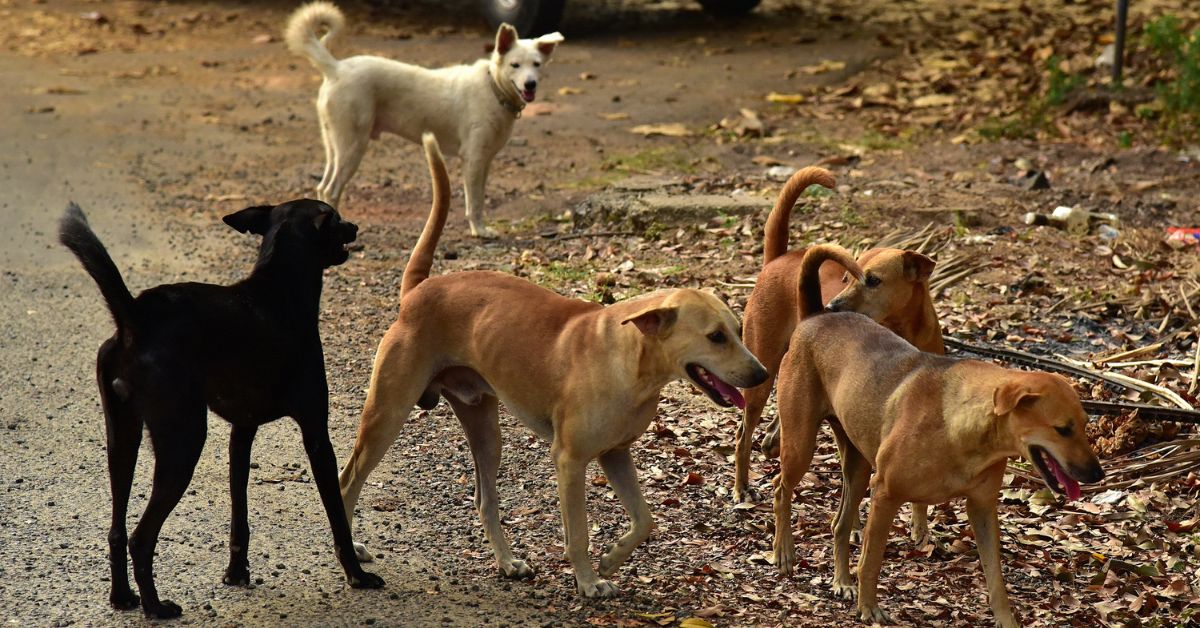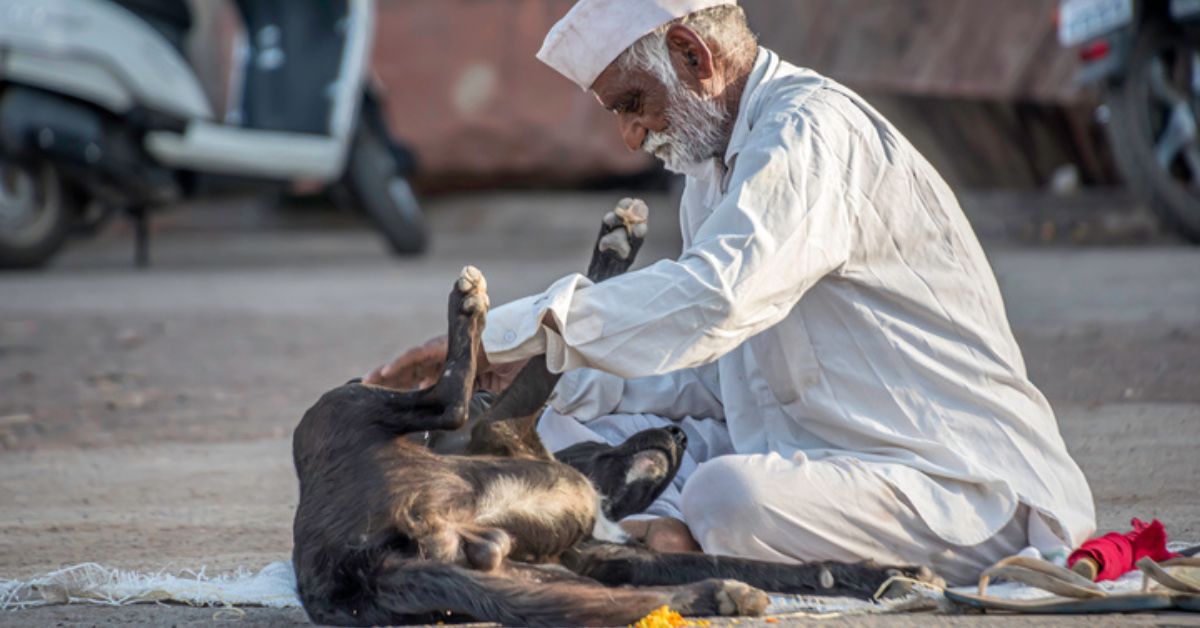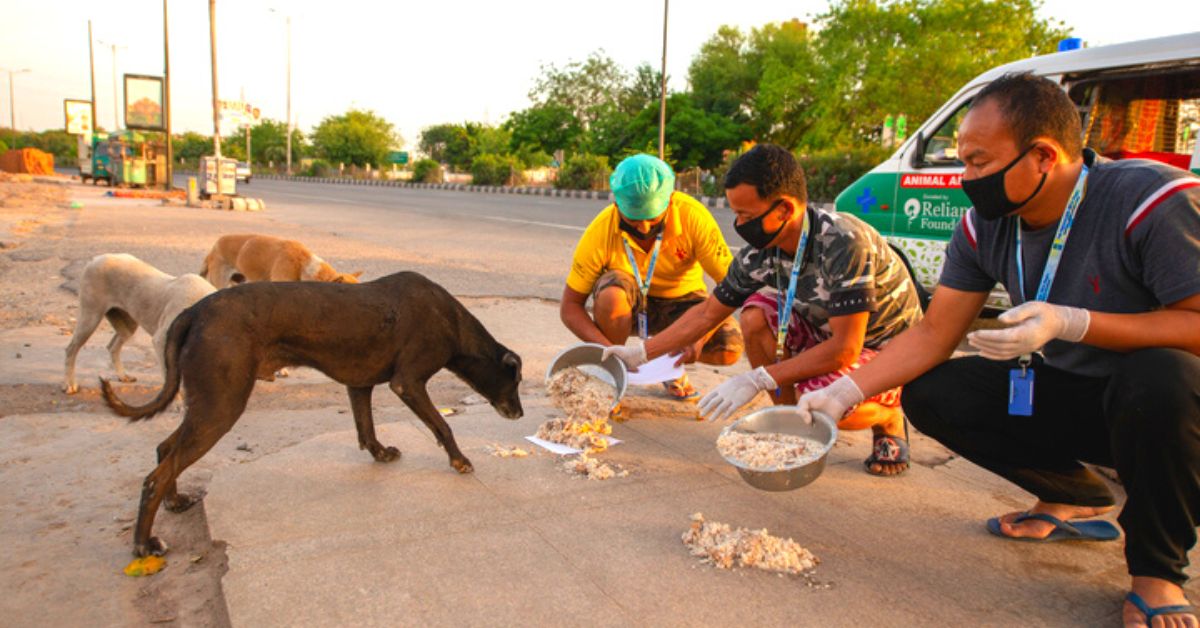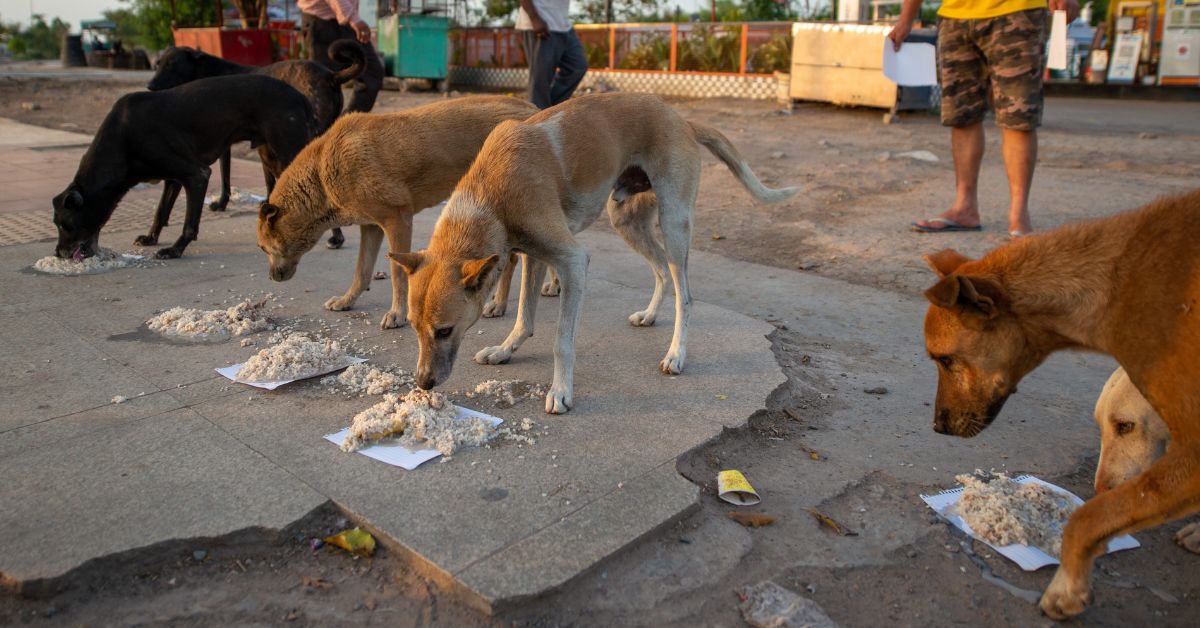Deep Dive: Why Indian Cities Are Struggling to Deal With Stray Dogs
In Part 1 of this two-part explainer we speak to experts in animal and disease ecology and animal rights activists to understand a highly debated concern about animal rights in India — are street dogs really a problem? In this story, we try to understand the underlying issues.

On 10 March, two children aged 7 and 5 were reportedly killed by free-ranging (“stray”) dogs (FRDs) in a forest close to their slum cluster in the Vasant Kunj area of New Delhi.
According to The Hindu, the post-mortem report stated that the victims suffered “multiple canine bites to their neck, head and spine”. These bites “were the primary causes of shock and haemorrhage, which led to their deaths”. This isn’t the first time FRDs have killed people in India.
Dr Aniruddha Belsare, assistant professor of disease ecology at Auburn University, has listed 86 cases of stray dogs committing either serious or fatal attacks on humans in 2022, resulting in 33 deaths across the country. Of these, 27 were among children under the age of 13. This data was based on reports published in English newspapers and media outlets.
Meanwhile, as per data collected by Dr Abi Tamim Vanak, an animal ecologist, conservation biologist and faculty at the Ashoka Trust for Research in Ecology and the Environment, more than 300 people, primarily children from poor and rural families, have been killed or grievously injured by dogs between 2016 and 2020. Although the National Crime Records Bureau (NCRB) doesn’t specify such direct FRD-related deaths, what’s not in dispute is that dogs on the street are killing people.
These figures don’t even take into account that dogs are the main vectors of the rabies virus in India. According to the World Health Organization (WHO), India accounts for 36% of the world’s rabies deaths, “causing around 18,000-20,000 deaths every year”. WHO also goes on to note that dog bites contribute “up to 99% of all rabies transmissions to humans”.
Data cited in the Indian Parliament reports that there have been nearly “16 million cases of stray dog bites between 2019 and 2022, an average of over 10,000 cases daily”.
On the other hand, however, animal rights activists have raised alarm over what they believe to be “mass hysteria surrounding dog bites”. This hysteria, they believe, has either resulted in fake news surrounding dog bite incidents or the indiscriminate killing of stray dogs.
One example of fake news is the recent case of a student at Shiv Nadar University, who murdered his classmate. During their investigation, the police noted that the university “initially said it was a case of dog bite, and refused to cooperate,” according to The Indian Express. This false claim made its way to social media platforms before it was eventually debunked.
This mass hysteria, however, has also resulted in horrific acts of cruelty against stray dogs, including instances where they were beaten to death.
How can we strike a balance between protecting the welfare of stray dogs while also protecting innocent people from getting attacked by them?
It’s evident that there is a growing problem of stray dogs in our cities and the rural countryside. This problem, some experts believe, underpins the failure of government policy and animal rights activism in not just protecting vulnerable people, but also the welfare of stray dogs.

Are stray dogs the problem?
Until 10 years ago, Huma Hazarika Sharma hated dogs and never cared for them. Even if she saw a puppy on the road, she would turn around right away. One day in 2010, however, a street dog named Jeffery befriended her when she was living in Vasant Kunj, Delhi.
“Over time, I slowly warmed to him. He would come home to sleep at night and would let us know when he wanted to be let out. Jeffery was a friendly dog with a protective presence. Every time, I would come back home late and get off at the market near my place, he would walk back with me to ensure I was fine. This entire episode taught me how well animals can bond with us if treated well. Jeffery was an adorable dog who had never bitten a soul, but he would bark at strangers. After all, it’s what dogs do because they’re territorial creatures. A dog barking at you doesn’t mean it’s going to bite, unless you provoke or become violent towards it,” she notes, speaking to The Better India.
In 2014, Huma rescued her first dog, a two-month old puppy bitten by other dogs, who was lying injured for about 24 hours and suffering from hypothermia.
“Three different veterinarians (vets) told me that he wouldn’t survive and that I have to put him down. However, after recovering for a week, he survived. When I rescued him, I realised the rest of the litter had been bitten by other dogs and only one of his siblings was left. So, I adopted his sibling too. Today, I have 10 dogs who live with me. It has been hard finding good homes for my dogs. A lot of people adopt dogs for appearances sake and don’t really take care of them. There’s no commitment on their part to look after them,” she says.
Early on, Huma would rescue and foster every dog herself. Growing attachment to these dogs, however, meant she didn’t have the heart to leave them back on the streets.
“Now, I rescue remotely. People, primarily from the poorest quarters of Delhi-NCR, get in touch with me, send me a video of the injured dog with the location, and I send an ambulance there. Once the ambulance picks up the injured dog, I either send them to a clinic or a medical boarding where they recover. A lot of these dogs don’t make it because of the severity of their injuries. Those who survive following treatment are sterilised and released back into the area where we first found them. I do this rescue work independently,” she explains.

Huma does not believe that street dogs are the problem.
As she explains, “We’ve taken over forests, cut down trees and taken their territory to build our homes. It’s unfair to displace them and have them suffer because we decided to take over their territory. When street animals or community animals are well taken care of and when they can trust the humans living around them, they will generally not bite.”
“Dogs bite when they’re provoked. I’ve seen people throw stones at them, chase them away and been nearly run down by cars. There are people who are generally cruel to animals living on the streets. If you’re cruel to these dogs, how can you expect them not to react?” she adds.
Huma acknowledges the tragedy of people getting mauled to death by street dogs, but believes that such episodes are the exception and not the norm.
“You have to go back and see how these dogs have been treated in a particular area. While there might be people who take care of them, there are others who are cruel. You have a lot of residential societies in Delhi-NCR where security guards are instructed to hit street dogs and drive them away. If you’re treating these dogs cruelly, what else do you expect? I’m not justifying the mauling of a child, but acts like these are a reaction to how they’re treated,” she says.

Vasundhara Anand, co-founder of KVAAB Welfare Foundation, a non-profit, shares the same sentiment. “We take care of 250 community dogs in Central and South Delhi. These community dogs live on a fixed route of about 25 kilometres. We have set locations where we feed them like the Panchkuian Furniture Market, NSIC Okhla Grounds, etc. Essentially, we feed and vaccinate them, while also catering to their medical needs as well. More than 80% of the dogs under our care are vaccinated and neutered. At Panchkuian Market, 100% of the community dogs are spayed and neutered. Now, we are expanding into community outreach,” she says.
In fact, she takes things a step further. “According to me, there is no concept of ‘stray dogs’. They have been living here before the buildings were constructed. We have built a community around these dogs. Stray means there is no ownership or these animals are just lost pets. They are not strays. This is their territory. It’s just that we have to learn to coexist with them. For example, the Panchkuian Market has developed around the dogs who were already residing there. Why should they be relocated?” she argues.
Dr Vanak, however, does not buy the argument that humans have encroached on the natural habitat of FRDs. He believes such arguments “lack a complete understanding of ecology, wildlife, ecosystems, biodiversity, nature and our own relationship with animals”.
“Dogs, a direct descendent of the grey wolf, Canis lupus, were one of the first domesticated animals. Humans have encroached on the habitat of wolves, but to argue that we have done the same to dogs makes little sense. Dogs are commensal species or they’re domesticated species. So, there is no question of dogs living without humans,” he tells The Better India.
“If dogs are indeed wildlife and we are encroaching upon their habitat, then why are you sterilising them? Why are you feeding them on the road? Why are you rescuing them from the street and adopting them in human homes? If they’re wild animals, you shouldn’t be doing any of those things. If the streets are a natural habitat of dogs, it should be illegal to adopt them,” he adds.
He also strongly disagrees with the notion that stray dogs attack only when provoked. “Dogs, which have been trained to attack, attack people when provoked. Street dogs, on the other hand, will attack for various reasons. They’ll attack when they’re territorial. When do they become territorial? When they guard the area where they get food. That is their territory. If you feed the dog on the street that area becomes its territory,” he says.
According to the ‘Revised Module for Street Dog Population Management, Rabies Eradication and Reducing Man-Dog Conflict’, published by the Animal Welfare Board of India (AWBI), “unprovoked” bites might occur when “male dogs are chasing a female which is on heat, and may tend to bite passers-by” and because “dogs in packs follow their leader (alpha male) and tend to behave accordingly”.
In both circumstances, the AWBI claims that sterilisation offers a panacea. It’s a common belief that sterilisation “reduces” aggression in stray dogs, but there is no conclusive evidence. According to a 2021 paper titled ‘Influence of Gonadectomy on Canine Behavior’ by authors including Dr Clara Palestrini, a professor of veterinary medicine at the University of Milan and member of the European Board of Veterinary Specialisation (EBVS), “There is a common belief that castration reduces aggression, but there is an absence of agreement in the literature.”
“Interestingly, their individual territoriality breaks down when you have excess food gathered in one area. You’ll often see many dogs gathering around a garbage dump for food. There’s no territoriality between those dogs there because food is in excess. But what happens then is that they start forming packs. As pack size increases, their aggression increases and their hunting instinct takes over. Then if they see something they can hunt down, they’ll attack,” says Dr Vanak.

According to him, that’s what you see when they maul people to death.
For example, in mid-April 2023, a 65-year-old man was mauled to death by a pack of stray dogs in a park on the Aligarh Muslim University (AMU) campus.
Look at the sequence of events in the CCTV footage below (Trigger warning: The video may cause distress). It starts with the arrival of one dog who bites him, following which a few more join in. They all started biting, chasing and surrounding him. Once he falls down, they all attack him.
“What you’re seeing is a classic initiation of a hunting attack. Whenever you have packs of dogs, they will hunt. That’s exactly what happens whenever anybody gets attacked, killed or mauled. It’s not provocation, but pack formation that leads to deadly attacks on people. And why does pack formation happen? It happens whenever you have massive resources gathered in one place. Feeding one or two dogs is fine, but when you feed five, seven or ten dogs at one location, that’s when pack formation occurs,” says Dr Vanak.
“Over the course of going through CCTV footage of people getting mauled by dogs, it’s apparent that there is no provocation from the victim whatsoever,” he adds.
Understanding the underlying issues
The recent State of Pet Homelessness Index data indicated that there are around 62 million stray dogs in India. Other studies peg the number at 80 million, 35 million or 15 million.
Whatever the real figures, these strays are currently governed under the Animal Birth Control (ABC) Rules 2023, which require them to be caught, neutered, vaccinated [for rabies], and released (CNVR) back into the community. These rules were first introduced in 2001 and amended in 2010, and once again in 2023. With the exception of a couple of amendments, the underlying principle of CNVR hasn’t changed to control the dog population.
Keren Nazareth, the director of the Street Dog Program at Humane Society International/India, believes that the government hasn’t done enough to ensure the success of these rules.
“ABC needs a real chance to be implemented in a country so vast. In 22 years since it came out, there has been no concerted plan, adequate resources and political will backing a national programme. We cannot look at dogs as just numbers, but living breathing animals that need to be cared for and supported in a way that over a period of time populations decline. Until the late 90s, India was open to culling dogs brutally, which is why ABC came in. The policy needs backing. We need to put our money where the policy is,” she notes to The Better India.
As per ABC’s revised module, “Most Indian civic bodies have been killing street dogs for decades, some since the last century. The concept was directly imported from the developed countries without any understanding of the different urban and rural conditions in developing countries.”
The report also notes, “In countries such as India, where exposed garbage and slums encourage the existence of street dogs, killing or removing them has proved ineffective in controlling rabies or the dog population. This is because the street dogs that are removed or killed are easily replaced with new dogs from other territories. They are also highly territorial, with each dog having its fixed niche.”
Keren notes, “If done properly, ABC can have an impact but it cannot be the only intervention. Work has to be done to make people aware of rabies, dog behaviour, what to do when dogs bite, why sterilisation and vaccination is essential and much more. We need information, awareness, service (spay, neuter, access to post-bite vaccines), good and fast health services and a plan. Our governments are not helpless, but plan-less. We need to get proactive.”
Huma also echoes similar sentiments. “NGOs and municipal authorities responsible for carrying this programme sometimes do a good job, but often they’ll release a dog on the streets without sterilising them. Sterilised dogs are often marked by the tip of their ear being cut off. There have been times when I’ve seen dogs with the tip of their ears cut off become pregnant and give birth to puppies. Also, municipal authorities release dogs wherever they want instead of sending them back to where they were first found,” she says.
She also sheds light on non-profits like Neighbourhood Woof in Rohini, Delhi, which sterilises dogs. Such non-profits have been contracted by the MCD to do this work, but have to constantly chase after them to pay their dues. “In these circumstances, how are they to ensure certain standards are maintained? How can they afford a good doctor, pay the person driving the ambulance, catchers and staff in general?” she asks.

Dr Vanak and Dr Aniruddha Belsare, however, believe that the ABC Rules reflect poor policymaking. “Currently, the rules as they are framed and animal rights organisations behind the writing of these policies have argued that having dogs homeless on the streets is not a problem. Their basic argument is that these streets are a natural habitat for dogs,” says Vanak.
This argument, which basically allows a large population of strays on the street, goes against all animal/dog welfare principles, he argues. City streets aren’t habitable for free-roaming dogs and leaving them there, Dr Vanak argues, is irresponsible. Moreover, dogs have very poor welfare outcomes on the streets.
“On the streets, their average life expectancy is between three to four years. Pup mortality is about 80%. They suffer from disease, injuries. Due to accidents on the road, you see a lot of maimed, limping and lame dogs. Dogs are also subject to extreme cruelty by people. I don’t see any upside to this policy of keeping dogs on the street,” he says.
“However, India’s policy is that dogs belong on the streets and then as per the new rules require that you have to actually maintain them on the streets, i.e. you have to feed them on the streets. The biggest myth that has been put out is that the ABC programme is the only way of controlling the dog population,” he adds.
Dr Vanak argues that we need to sterilise more than 90% of the stray dog population over a very short period of time, otherwise they’ll continuously find a way of reproducing. “We don’t have the capability to sterilise such large numbers of dogs in a short period of time. With the ABC programme, we’re barely scratching the surface,” he says.
In a recent Twitter thread, Dr Belsare argues that the ABC Rules reflect flawed policymaking. It hasn’t worked anywhere in the world to control free-ranging populations, he says.
“ABC has worked extremely well in many Western countries as they targeted pet dog populations (non-free roaming dogs). But there isn’t a single example where ABC alone has controlled free-roaming dog (FRD) populations. It does not work for large FRD populations because births prevented by ABC are compensated by remaining intact dogs; intact FRDs rapidly replace neutered dogs as birth and mortality rates are high,” he notes.
You can read more about his findings in this recent paper published in the Nature journal.
He goes on to note that for exactly the same reasons, “indiscriminate killing/shooting/poisoning of FRDs does not work!” He adds, “Population control efforts for free-roaming animals have to be geographically coordinated, systematically implemented and sustainable.”

The only way, he believes, a policy like ABC will work if it’s “systematically implemented throughout the country, not just in a few urban centres.” Even then, he argues, the cost to the exchequer is just too high.
Say there are 60 million stray dogs in the country.
He notes that for ABC to be effective, authorities will have to at a minimum sterilise 42 million dogs in six months. “Let’s go with a very conservative estimate of INR 500 per neutering surgery,” he notes. The total cost of this endeavour will come up to Rs 2,100 crore. In 2021-22, the union budget for the Department of Animal Husbandry and Dairying was Rs 3,100 crore.
On a policy front, what India has today are scattered ABC programmes, which Dr Belsare argues is a “complete waste of taxpayer money”.
“Dogs are very fecund, i.e. they reproduce very quickly, and since we are not living on islands where no new animals are coming from the countryside or from other places, populations will always rebound. People are contributing to the problem of dogs on the streets as well, because their adopted dogs or their pedigree dogs are allowed to mate with other dogs, or they are abandoned on the streets,” says Dr Vanak.
“There are always dogs coming in from outside that are able to reproduce. Over a very short period of time, they’re able to populate areas. Employing reasoning based on basic biology and ecology, it’s easy to see that where there are resources, you will find animals. Stopping these resources is the first point of stopping the growing street dog problem, which is something none of our current policies bother about. In fact, people are effectively going around feeding dogs all over the place and contributing to increasing the problem rather than solving them,” he adds.
To conclude, on the one hand, there has been a collective failure to properly implement the ABC programme in the past two decades. On the other hand, however, there is a strong argument to be made that the ABC policy is flawed by design when it comes to reducing the number of stray dogs in our streets while also protecting their welfare. If you found our stories insightful, informative, or even just enjoyable, we invite you to consider making a voluntary payment to support the work we do at The Better India. Your contribution helps us continue producing quality content that educates, inspires, and drives positive change. Choose one of the payment options below for your contribution- By paying for the stories you value, you directly contribute to sustaining our efforts focused on making a difference in the world. Together, let’s ensure that impactful stories continue to be told and shared, enriching lives and communities alike. Thank you for your support. Here are some frequently asked questions you might find helpful to know why you are contributing?

In Part 2, we will discuss some of the solutions to address the growing stray dog problem in our cities.
(Edited by Divya Sethu; Images courtesy Shutterstock)
This story made me
-
97
-
121
-
89
-
167
















